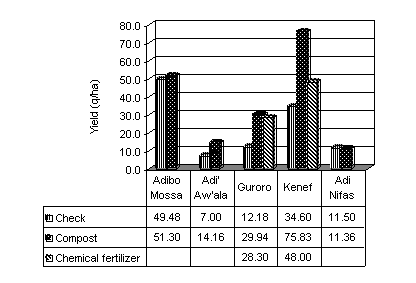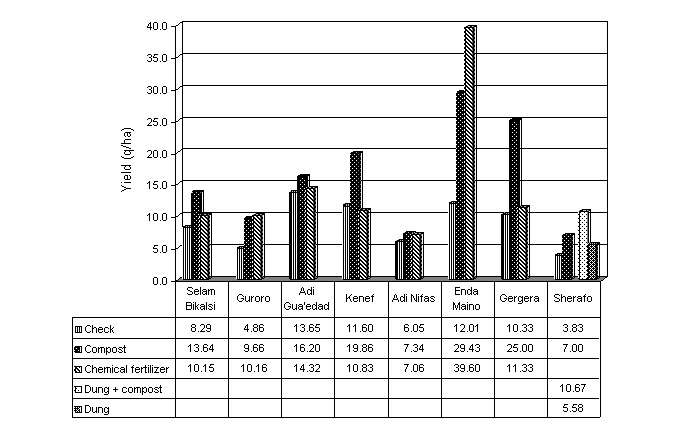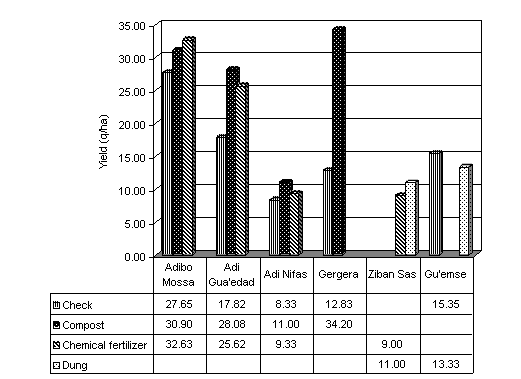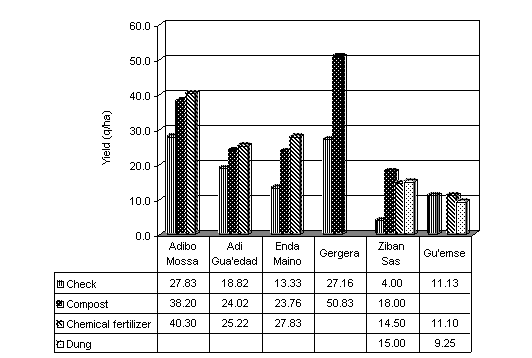Greening Ethiopia for Self-Sufficiency
Famines and Ethiopia and other African countries have become irrevocably linked in the public mind since Bob Geldof’s Live Aid Concert in the 1980s. In 2002, we carried the first and only report (Science in Society #16) on how Ethiopia is determined to feed herself. In this present exclusive mini-series, we update the entire story of the remarkable successes achieved in reviving the traditional farming practice of pit composting that has now convinced Ethiopia to adopt organic agriculture for the entire country.
Organic Production for Ethiopia
The Tigray Project
Greening Ethiopia
Sue Edwards reports on a project that could launch Ethiopia on her way to self-sufficiency.
"Is there sufficient biomass in Ethiopia to make adequate quantities of compost?" This is the question most often raised whenever there is any suggestion that Ethiopia could use organic principles to increase crop yields.
In 1995, Dr Tewolde Berhan Gebre Egziabher, on behalf of the Institute for Sustainable Development (ISD), was asked by some government officials to design a project that could be promoted with farmers of poor and marginal areas in order to improve the productivity of their land and rehabilitate their environments. The project started in 1996 under the supervision of the Bureau of Agriculture and Natural Resources (BoANR) of Tigray. The other partners in the project are Mekele University, the local communities and their local administration.
Project activities in four communities were established in 1996/97 and 1997/98. After 2000, the project was extended to 11 other communities, with more than 634 people now participating. Much effort has been made to include households headed by women in the project because these are generally among the poorest of the poor in their villages.
Since 2002, the BoANR has been promoting the compost-making 'package'- trench bunding and planting multipurpose trees, particularly Sesbania - in over 90 communities within 25 Woredas (administrative districts) in the more marginal areas of the Region.
In November 2001, ISD had some preliminary yield data showing the positive effects of using compost (first reported in SiS 16).
More data on yields were collected in 2002, and these were equally impressive. Compost generally gave the highest yields, often out-performing chemical fertilizers, in a variety of crops and over the entire range of ecosystems from the moister areas in Southern Tigray with fertile alluvial soil, to the deforested Central Zone with moderate rainfall, and the arid Eastern Zone with poor, thin sandy soil (see below).
As each community grows a different mix of crops types and varieties, only the data that could be compared are presented. It should be noted that 2002 was a drought year, and many crops failed altogether. For example, only Adi Gua'edad and Adibo Mossa had successful harvests of faba bean; field pea only in Adibo Mossa; and finger millet only in Guroro and Adi Nifas. In years with better rainfall, most communities would grow at least one pulse crop.
An important feature of the Tigray Project is that it is to a large extent led by the farmers. They choose which crops to treat with compost and which with chemical fertilizer. Sampling was done with the farmers. Fields were designated/chosen with the farmers and 3 one-meter square plots were cut and threshed, and the straw and grain weighed separately with the farmers.
Each figure presented in the table is the average from several fields of the same crop variety in the same area given the same treatment. 'Check' means the field received no treatment in 2002, although it may have received compost in one or more previous years. 'Compost' is for fields treated with mature compost. The rates of application range from around 50 q/ha (1 quintal = 100 kg, hence 50 q can be represented as 5000 kg) in poorly endowed areas, such as the dry Eastern Zone of the Region (Zeban Sas and Gu'emse), to around 150 q/ha in the moister Southern Zone (Adibo Mossa). 'Chemical fertilizer' is for fields treated with DAP (diammonium phosphate) and urea. The recommended rates are 100 kg/ha of DAP, and 50 kg/ha of urea.
The original data were collected site by site, but here they have been compiled by crop: figures 1-4 for maize, tef, wheat and barley, respectively. Table 1 gives the yields for faba bean, field pea and finger millet for 2002 with yields for 1998/99 for the Southern Zone included for comparison.

Figure 1. Maize yields in 5 sites

Figure 2. Tef yields in 8 sites.

Figure 3. Wheat yields in 6 sites.

Figure 4. Barley yields in 6 sites.
| Crop/Location/year | Check | Compost | Chemical fertilizer |
| Finger Millet/ Adi Nefas/02 | 4.2 | 16.8 | |
| Finger Millet/ Guroro/02 | 5.1 | 11.1 | |
| Faba Bean / Adibo Mossa/98 | 3.4 | 15.0 | |
| Faba Bean / Adibo Mossa/02 | 25.7 | 26.3 | |
| Field Pea / Adibo Mossa/98 | 2.5 | 12.8 | |
| Field Pea / Adibo Mossa/02 | 26.4 | 27.7 | |
| Faba Bean / Adi Gua'edad/02 | 23.8 | 34.0 | 34.9 |
Table 1: Yields (q/ha) for faba bean, field pea and finger millet in 4 sites;
1998 compared with 2002.
The farmers' experience
As the data show, yield increases whenever compost is applied. The yields from compost are comparable, and higher than those from chemical fertilizer. Farmers who have learnt how to make and use compost effectively are not interested in continuing to use chemical fertilizer, i.e. they have willingly withdrawn the use of chemical fertilizer without any loss in production. Some farmers are even making their own observations on comparing compost with animal dung and/or chemical fertilizer.
It is interesting that the yields of the check and composted crops (maize, wheat, barley, field pea and faba bean) in Adibo Mossa in the Southern Zone show little difference. The farmers here apply about 150 q/ha of compost to their fields, the highest rate of any of the sites. It is possible that the soil is sufficiently rehabilitated (since 1998) to give good yields without compost being applied every year.
Farmers, development agents, and ISD staff have identified the following as the positive effects of using compost:
Some farmers diversified their production once the quality of their land improved. For example, one farmer in Adi Nifas now regularly plants vegetables, particularly tomato and chilli pepper in his tef field. These do not interfere with the tef, maturing after the grain is harvested and bringing the farmer additional income.
In Adi Nifas, where the main gullies and hillside were treated with check dams at the start of the project, the stream from the hillside now holds water all year round, and several farmers downstream have developed irrigated vegetable production after they harvested their grain crops. They are able to regularly get two crops a year.
Many farmers have also started to plant fruit trees, both around their homesteads and in rehabilitated gullies.
Note: The data from the Tigray project were collected by Arefaine Asmelash and Hailu Araya, and analysed and compiled by Hailu Araya, Sustainable Community Development Team Leader in ISD.
Article first published 24/06/04
Comments are now closed for this article